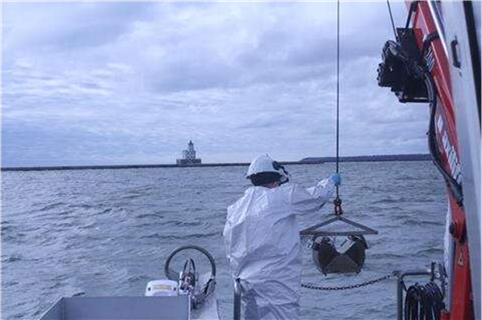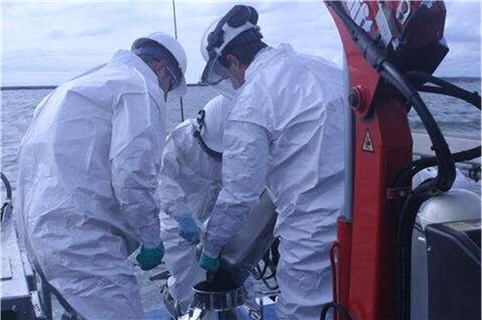by National Institute of Standards and Technology

Researchers
use the Ponar grab to extract sediment samples from the lakebed in Milwaukee
Bay. Credit: M. Ellisor/NIST
People
who live near the Great Lakes might go there to enjoy a swim or a boat ride.
But if you're visiting from the National Institute of Standards and Technology
(NIST), you might go boating for science.
Collaborating
with researchers from the Environmental Protection Agency (EPA) and the
National Oceanic and Atmospheric Administration (NOAA), NIST researchers
collected freshwater sediment samples from
Milwaukee Harbor in Lake Michigan.
Their
overarching mission is to help scientists accurately measure organic pollutants
in the environment. To help do so, NIST has released a reference material
containing carefully measured organic contaminants in Great Lakes sediment.
Measurements
are important in understanding the impact of pollutants on the environment and
how that in return affects us. "It's important to know water and soil
quality. You don't want to be near contaminated sediment or eat contaminated
fish," said NIST researcher Jessica Reiner.
Reiner
and her colleagues want to further improve measurements of persistent organic
pollutants (POPs), toxic chemicals that can negatively affect human health and
the environment. They last for long periods of time and aren't easily broken
down. Many POPs were first produced after World War II and introduced
commercially for agriculture, manufacturing and other uses. But unfortunately,
these organic pollutants can also pass through the food chain from one species
to another.
Concerns
are rising about POP concentration in freshwater regions such as the Great
Lakes, which border the northern part of the U.S and southern Canada.
Freshwater bodies are important as they're sources of our drinking water.
Collectively, the Great Lakes make up the largest body of fresh water on the
planet and account for one-fifth of the total fresh water on Earth, around 6
quadrillion gallons of water.
The
EPA is working to reduce organic pollutants found in the Great Lakes,
concentrations of which are known as Areas of Concern (AOC). With information
about the AOCs, NIST worked with NOAA to find sites in the Great Lakes in which
specific pollutants are known to be present.

NIST
researchers collected sediment material from three different sites in Milwaukee
Bay. The sediment was put in stainless steel milk cans for storage before being
transported to Hollings Marine Laboratory for sample analysis. Credit: M.
Ellisor/NIST
NIST
researchers focused on two types of POPs: Polycyclic aromatic hydrocarbons
(PAH) and per- and polyfluoroalkyl substances (PFAS). PAHs are a group of
chemicals naturally found in coal, crude oil and gasoline and are also released
into the environment from the burning of coal, oil, gas, wood, solid waste and
tobacco. PFAS are a group of chemicals found in products made to resist heat,
oil, stains, grease and water. They can be found in everything from clothing
and furniture to the insulation of electrical wires.
Both
are a concern because they do not easily break down in the environment and can
move through soils to contaminate drinking water sources like rivers and lakes.
Increasing evidence suggests that PFAS and PAHs have detrimental health
effects.
Over
the years NIST has developed a variety of environmentally related SRMs, but
until now there was not a freshwater sediment reference material available for
the scientific community with values for organic contaminants. NIST's new SRM
1936—Great Lakes Sediment—enables scientists to validate the methods they're
using when measuring for organic pollutants in their own sediment samples.
NOAA
researchers collected sediment samples from various AOCs around the Great Lakes
region, which helped NIST researchers pick the sample site of Milwaukee Harbor
for their sediment samples. Researchers then took a boat out to three different
sites in Milwaukee Harbor, part of Lake Michigan. They used the Ponar grab, a
metal device that's lowered to the bottom of the lake, to scoop up samples from
the lakebed. The sediment samples were placed in stainless steel cans before
they were transported to the Hollings Marine Laboratory in Charleston, South
Carolina, for storage.
The
batches of sediment then went to the main NIST campus in Gaithersburg,
Maryland. Workers there broke the sediment down into a uniform consistency and
bottled it. The bottled samples returned to Charleston, where scientists
analyzed and characterized the organic pollutants in them.
The
organic pollutants in the Great Lakes sediment SRM will be useful for
regulatory environmental agencies such as the EPA and NOAA, as well as state
agencies, to help with ongoing efforts in monitoring trends of organic
pollutants in the Great Lakes area, which will determine if contaminant
reduction efforts are working. The SRM will also be beneficial to scientists
working in analytical chemistry laboratories conducting research on PFAS and
PAH measurements and analyzing their own soil samples for specific pollutants,
as well as academic labs.
SRM
1936 will be replacing SRM 1944 (New York/New Jersey Waterway Sediment) and SRM
1941b (Organics in Marine Sediment). But it's not the only SRM that deals with
organic pollutants like PFAS. NIST also has a domestic sludge SRM and fish
tissues SRMs specific to Lake Michigan and Lake Superior.
(Source: https://phys.org/news/)

